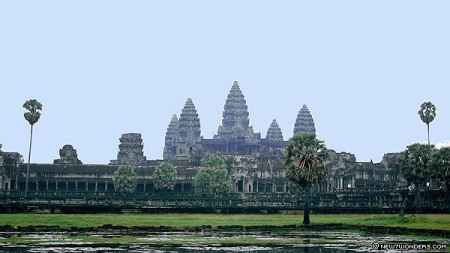Angkor Cambodia

Back in 2007 a group of people started putting together what was to be called The New Seven Wonders of the World. While based off the same ideas of grandeur of architecture and/or nature, this time was different because people from all over the world got to vote on the final 7 online. 21 sites around the world were put up for vote on the website, and although it did not make the final 7, Angkor, Cambodia was one of the nominations.
Angkor Wat is the most important of the major temples built at Agkor, Cambodia and is the world’s largest sacred temple. It was built sometime between 1113 and 1150. It is noted for its intricate ornamentation and striking beauty of its high quality bas-relief carving. It is surrounded by a moat 570 feet wide and about four miles long. The temple itself symbolizes the Hindu cosmos: Oceans surrounding a mountain at the center. Definitely the largest and most important, it is not the only temple to be discovered.
There are 8 other major temples open to the public: Bakong , Banteai Srei, The Baphuon, The Bayon, Preah Ko, Preah Khan, Ta Prohm, and Ta Keo. There very well may be other temples, but the integrity of the sites makes it dangerous for tourist to visit, and archeologists are still studying the finds.
For hundreds of years the “Lost city of Angkor” was considered to be only a legend. Cambodian peasant would find pieces of rubble that they claimed to have come from the “temples built by the gods or giants. They were dismissed by early European settlers as superstitions or myth.
In 1860, an archeologist named Henri Mahout, following up on the folk tales made the official discovery of the lost Angkor temple region. He said of it "One of these temples—a rival to that of Solomon and erected by some ancient Michelangelo—might take an honourable place beside our most beautiful buildings. It is grander than anything left to us by Greece or Rome, and presents a sad contrast to the state of barbarism in which the nation is now plunged.” . The “lost city” was soon besieged by archaeologists, historians, and explorers – all seeking to discover what this city had been for. For the next century the city was studied, reconstructed, and opened to the public.
The temples were originally Hindu, dedicated to Vishnu, but in the 14th or 15th century were converted to Theravada Buddhism, and remain so today. Though most of the bas-relief friezes do depict Hindu scenes, such as the Ramayana (the Hindu epic which explores Dharma or human’s spiritual responsibilities) and the 32 hells and 37 heavens of Hindu mythology.
Angkor has become a major tourism spot in Cambodia today, pulling in not only outsiders, but also those from within the country wishing to make a spiritual journey. It has been likened to the Christian journey of visiting Israel.
In this day of shiny-new, and streamlined aerodynamic architecture that seems to be taking over the world; the temples of Angkor bring back a beauty and grandeur and remind us that man was at one time capable of creating art with his architecture.
 |
Angkor Wat is the most important of the major temples built at Agkor, Cambodia and is the world’s largest sacred temple. It was built sometime between 1113 and 1150. It is noted for its intricate ornamentation and striking beauty of its high quality bas-relief carving. It is surrounded by a moat 570 feet wide and about four miles long. The temple itself symbolizes the Hindu cosmos: Oceans surrounding a mountain at the center. Definitely the largest and most important, it is not the only temple to be discovered.
There are 8 other major temples open to the public: Bakong , Banteai Srei, The Baphuon, The Bayon, Preah Ko, Preah Khan, Ta Prohm, and Ta Keo. There very well may be other temples, but the integrity of the sites makes it dangerous for tourist to visit, and archeologists are still studying the finds.
For hundreds of years the “Lost city of Angkor” was considered to be only a legend. Cambodian peasant would find pieces of rubble that they claimed to have come from the “temples built by the gods or giants. They were dismissed by early European settlers as superstitions or myth.
In 1860, an archeologist named Henri Mahout, following up on the folk tales made the official discovery of the lost Angkor temple region. He said of it "One of these temples—a rival to that of Solomon and erected by some ancient Michelangelo—might take an honourable place beside our most beautiful buildings. It is grander than anything left to us by Greece or Rome, and presents a sad contrast to the state of barbarism in which the nation is now plunged.” . The “lost city” was soon besieged by archaeologists, historians, and explorers – all seeking to discover what this city had been for. For the next century the city was studied, reconstructed, and opened to the public.
The temples were originally Hindu, dedicated to Vishnu, but in the 14th or 15th century were converted to Theravada Buddhism, and remain so today. Though most of the bas-relief friezes do depict Hindu scenes, such as the Ramayana (the Hindu epic which explores Dharma or human’s spiritual responsibilities) and the 32 hells and 37 heavens of Hindu mythology.
Angkor has become a major tourism spot in Cambodia today, pulling in not only outsiders, but also those from within the country wishing to make a spiritual journey. It has been likened to the Christian journey of visiting Israel.
In this day of shiny-new, and streamlined aerodynamic architecture that seems to be taking over the world; the temples of Angkor bring back a beauty and grandeur and remind us that man was at one time capable of creating art with his architecture.

Related Articles
Editor's Picks Articles
Top Ten Articles
Previous Features
Site Map
Content copyright © 2023 by Michelle Taylor. All rights reserved.
This content was written by Michelle Taylor. If you wish to use this content in any manner, you need written permission. Contact Hanny Suriadi for details.


